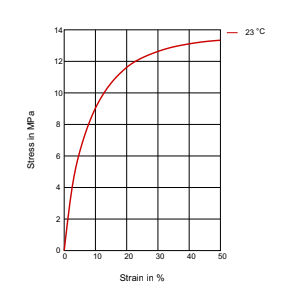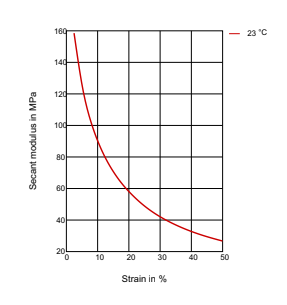Enhanced TDS
Identification & Functionality
- Additives Included
- Blend
- Yes
- Chemical Family
- Country of Origin
- Polymer Name
- Product Code
- MITM15421
- Single Ingredient
- No
- Technologies
- Product Families
Features & Benefits
- Labeling Claims
- Materials Features
Applications & Uses
- Plastics & Elastomers End Uses
- Plastics & Elastomers Processing Methods
- Processing Information
Injection Molding, Film Extrusion, Profile Extrusion, Other Extrusion, Transfer Molding, Casting, Thermoforming.
Properties
Technical Details & Test Data
- Technical Data
Stess-Strain Diagram:

Secant Modulus-Strain Diagram:

Processing Conditions (Injection):
- Typical melt temperature (Min / Recommended / Max): 200°C / 240°C / 270°C.
- Typical mold temperature: 25 - 60°C.
- Drying time and temperature (only necessary for bags opened for more than two hours): 4-8 hours at 65-75°C.
Processing Conditions (Extrusion):
- Typical melt temperature (Min / Recommended / Max): 210°C / 220°C / 230°C.
- Drying time and temperature (only necessary for bags opened for more than two hours): 4-8 hours at 65-75°C.
Packaging & Availability
- Packaging Type
Principal Information
- Group Principal Number
- S000003
- Principal
Other
- Color (SDS)
- Colorless to slightly yellow
- Insoluble in (SDS)
- Water
- Item Number
- Odor (SDS)
- Odorless
- Other Hazards
- Processing may release vapors and/or fumes which cause eye, skin and respiratory tract irritation, The product, in the form supplied, is not anticipated to produce significant adverse human health effects. Contains high molecular weight polymer(s). Effects due to processing releases: Irritating to eyes, respiratory system and skin, Prolonged or repeated exposure may cause: headache, drowsiness, nausea, weakness, (severity of effects depends on extent of exposure) .
- Temperature Control
- Yes
- USA/DOT UN Number
- Not Applicable
- Material Composition
Value Units Test Method / Conditions Carbon Content 62.0 % % ASTM D6866 - Mechanical Properties
Value Units Test Method / Conditions Hardness 51.0 Shore D Shore D Hardness 51.0 Shore A Shore A ISO 868 Strain at Break min. 300.0 % % ISO 527-1 at break thermoplastic elastomer, dry Strain at Break min. 50.0 % % ISO 527-2 at break, condensed Stress 13.4 MPa MPa ISO 527-2 at 50% strain, condensed Stress at Break 45.0 MPa MPa ISO 527-1 at break thermoplastic elastomer, dry Tensile Modulus 160.0 MPa MPa ISO 527-2 condensed - Physical Properties
Value Units Test Method / Conditions Density 1030.0 kg/m³ kg/m³ ISO 1183 condensed Density 1030.0 kg/m³ kg/m³ ISO 1183 dry basis Humidity Absorption 0.7 % % ISO 62 dry basis Melting Point 167.0 °C °C ISO 11357-1 at 10°C/min Mold Shrinkage 1.0 % % ISO 2577 normal, dry Mold Shrinkage 1.0 % % ISO 2577 parallel, dry Mold Shrinkage 1.0 % % ISO 294-4 normal, dry Mold Shrinkage 1.0 % % ISO 294-4 parallel, dry Softening Point 156.0 °C °C ISO 306 at 50°C/h, 50N, dry Storage Temperature max. 140.0 °F °F Water Absorption 1.5 % % ISO 62 dry basis - SDS Physical and Chemical Properties
Value Units Test Method / Conditions Autoignition Temperature (SDS) 698.0-842.0 °F °F Bulk Density (SDS) 550.0-650.0 kg/m³ kg/m³ Decomposition Temperature (SDS) 572.0-662.0 °F °F Density (SDS) 1.03 g/cm³ g/cm³ Lower Explosion Limit (SDS) 62.0 % % at 85⁰C Melting Point (SDS) 333.0 °F °F Specific Gravity (SDS) 1.03 - at 23°C - Shelf Life & Stability
Value Units Test Method / Conditions Shelf Life 2.0 yr yr
